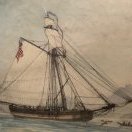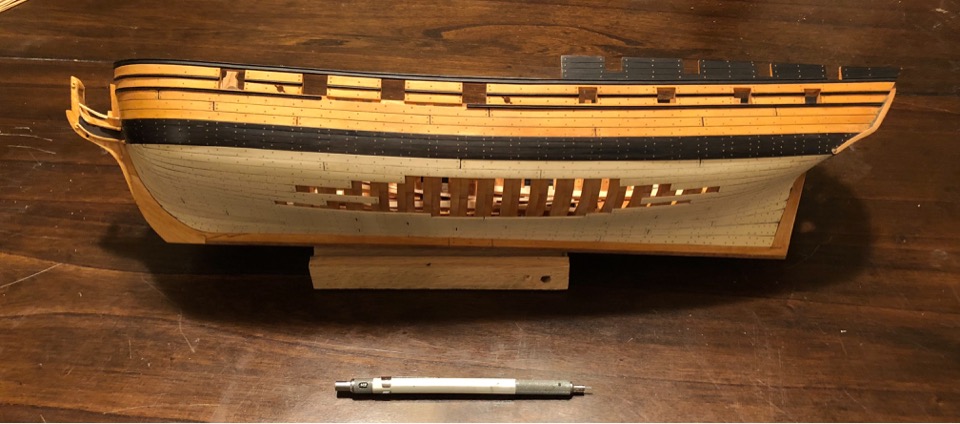-
Posts
375 -
Joined
-
Last visited
Content Type
Profiles
Forums
Gallery
Events
Everything posted by Dowmer
-
Jim, Yes you can, and it wouldn't hurt, but its not necessary. Due to the small scale of the boat the dowel would be a small treenail smaller than 1/32". As John stated above, the transom was sturdy it was once it had been glued with supporting sticks at the top. If you are gentle with your file when fairing its not an issue. I think we are being a bit excessive for a very simple operation. But every modeler can use methods that he is comfortable with. If a modeler wishes to "pin" the transom then by all means do so.
-
Looking good chuck. I like your method of lining the hull out. That’s a definite plan. Here’s a tip, you said you are cutting thin strips of the tape. That isn’t necessary. You can get artist dry erase tape or what we use for scale airplanes call “chart Pak” tape. It comes in narrow strips down to 1/64” if you want. Here’s a link to some that is 3mm, but you can get whatever width that strikes your fancy. It’s cheap. Chartpak tape link
- 421 replies
-
- medway longboat
- Syren Ship Model Company
-
(and 1 more)
Tagged with:
-
Chuck, I think he was talking about the top of the bulkheads and not necessarily the curved Sheer strake which is clearly marked on the plan. The sheer definitely has a nice curve to it like you have mentioned but the bulkheads seem to have less and don't necessarily follow the same curve or almost flat depending on how they fit. At least they did on mine. Later you cut/sand the top of the bulkheads down to match the curved sheer indicated on the plans if I remember correctly. The key I think is that the bulkhead frames seat properly down to the inside rabbet edge. Chuck, is that right?
-
Thanks Remco, your build is truly inspirational. I may have to make my own plugs. I wish I was more CAD, 3D printer savvy. I would think that someone could easily scale a plug to any size and print one out in no time at all.
- 1,207 replies
-
- sloop
- kingfisher
-
(and 1 more)
Tagged with:
-
Remcohe, fabulous build. I'm glad to hear your relocation went well to Sweden and perhaps you will be back into finishing the Kingfisher. Your talents are exceptional. Early on in the build you mentioned using an Admiralty model plug for the small boat (see above). I didn't see it on their website. Is this still available? How did you get it? I have some small boats to build and this would make life much easier. Also, how did you keep the planks from sticking on your plugs/molds with the glue? Also, what kind of glue did you use? There seems to be no sight of the glue in your woodwork of the Kingfisher. Sorry for so many questions Thanks
- 1,207 replies
-
- sloop
- kingfisher
-
(and 1 more)
Tagged with:
-

raising and lowering an anchor on a sloop
Dowmer replied to timboat's topic in Nautical/Naval History
Tim, This may be a bit late, but if you were still looking for contemporary references and not modern models for sloops, I would recommend you refer to Henrik Chapman's work Architectura Navalis 1768. Virtually all the small sloops and cutters from several nations referenced during this period have a Windlass. I'm not saying that all sloops and cutters had a capstan or windlass, but I would say that not having one was more the exception and not the rule. Particularly merchantmen, since they had fewer crew to man the tackles etc. -
Nice, even a little progress is still forward movement. Like you said, once you have the new quarterdeck secured things will speed up. Something to consider, if you are going to stain or dye your Wales black you might want to do that before your other planks go on to reduce the mess. Of course if you are painting then you can mask and it isn’t much of a problem. I’ll shut up now.
-
Lou, Good questions and I am by no means an authority. I suppose I showed my shallowness of knowledge LOL :). There are no doubt plenty of people following this thread that are more experienced than me, but I'll give it a go. I read Steel as two strakes for a total of 16". So two 8" planks. Specifically the document says Main Wales broad: 1'4" , Number of strakes: two. A 16" plank is pretty wide although doable back then but two 8" planks makes more sense to me. Especially sense it says Wales broad, not strakes. What I'm calling the rubbing strake is called in the book Thickstuff upon the Main Wales: one. 3" thick and 8" broad. I understand it was placed at the top of edge of the wales because after this the next line says Stuff of Topside. Diminishes from thickstuff upon the wales to under the edge of the sheer strake: 1 1/2" So the Thickstuff upon the wales would have to be on the top edge for the "topside stuff" to be adjacent to it. Does that make sense? What you said about the wales being a rubbing area is true, but it also served other functions like strengthening the hull. I think the rubbing strake or "thickstuff upon the wales" was just added protection and stiffening. On larger ships it shows "two" strakes. One at the top and another at the bottom of the wales if you look at some contemporary models like in the Rogers Collection. Yes, thickness measurements That sounds about right and reasonable to have a 9" plank. I think you are OK Lou If I messed this up, then someone please chime in.
-
Lou, my pleasure. I have enjoyed our conversations immensely. For planking here's some numbers for you from Steel's 1805 Shipwrights Vade Mecum so you know what you are shooting for plank thickness. If you already have a source then disregard. Only added so you can bounce it off your documentation and plank stock of what you have in your Lumberyard. :). Taken for a 60 Ton Sloop which should be close enough. Wales: 2 strakes 16" wide and 4" thick. There was a 3"x8" rubbing strake over the top of the wales if you choose to use it as well. Thickstuff under Wales: 3" thick tapering down to 2" for the rest of the bottom. Topside planks: From the Wales to the Sheer rail 1.5"
-
Looking good Lou, I hope our conversations off line have spurred you on. The hardest part is getting those first planks on. Everything else will flow after that. Its taking shape nicely. Looking forward to the progress. I'm not sure what the kit provided for wood stock for the wales but remember that the wales was thick stuff and the planking above and below it was thinner thickness. So you should see a discernable "step" as the planking changes thickness from wales to thinner upper and lower works. Just a reminder as you go forward.
-
Love the Lady Washington, now if I could only finagle a job working on her at Port Townsend shipyard. Some really great history with the original Lady Washington and the PNW.
- 16 replies
-
- brigs
- sailing ships
-
(and 1 more)
Tagged with:
-
Mark, If you take a look at the pic of my ship “Union” up above about 10 posts you’ll see what it looks like. I used Tung oil on it and it’s sat for about 15 years in a closet. The yellow is nice and warm but not too bright. I used it to approximate the yellow ochre paint that they used on 18th century ships. Either way, what Chuck said. Oils make it a bit darker and poly and sealer a bit lighter. And it sands and carves great with good flexibility in stits. But it will always be yellow, after all, it’s in the name
-
Vinnie, Check your sources for the bounty rigging. She may have used catharpins on the shrouds as well.
-
I guess you could always tint the wood glue black too. After wiping off the excess and it dries if leaves a soft fine edge. Never tried it but read about it. I guess I must have stayed in a Holiday Inn Express. BTW Chuck, your opening intro says the Longboat is 1:48 scale but I thought you were building to 1/2" scale or 1:24?
- 421 replies
-
- medway longboat
- Syren Ship Model Company
-
(and 1 more)
Tagged with:
-
Wow Chuck, really beautiful! Signed up and ready for more. I love the smaller working boats and Sloop rigs. By the way, I second the sentiments on Alaskan Yellow cedar. I've been using it for the past 15 years or so before it was "fashionable" and common for ship building. I always liked it, and it is a dream to work with. Smells good too when you are planning it in the shop.....if you like that sort of thing.
- 421 replies
-
- medway longboat
- Syren Ship Model Company
-
(and 1 more)
Tagged with:
-
Al, Lou, I agree, I love talking to the old guys. They have great stories to tell of a world that's long gone. But then again, I love history so I guess that is why I love ship modeling and talking to older generations so much. In fact not just ships. My other passion is RC Scale Aircraft...the big stuff 7-9 feet wingspan. I geek out with details and historical research just like I do with the ships.
About us
Modelshipworld - Advancing Ship Modeling through Research
SSL Secured
Your security is important for us so this Website is SSL-Secured
NRG Mailing Address
Nautical Research Guild
237 South Lincoln Street
Westmont IL, 60559-1917
Model Ship World ® and the MSW logo are Registered Trademarks, and belong to the Nautical Research Guild (United States Patent and Trademark Office: No. 6,929,264 & No. 6,929,274, registered Dec. 20, 2022)
Helpful Links
About the NRG
If you enjoy building ship models that are historically accurate as well as beautiful, then The Nautical Research Guild (NRG) is just right for you.
The Guild is a non-profit educational organization whose mission is to “Advance Ship Modeling Through Research”. We provide support to our members in their efforts to raise the quality of their model ships.
The Nautical Research Guild has published our world-renowned quarterly magazine, The Nautical Research Journal, since 1955. The pages of the Journal are full of articles by accomplished ship modelers who show you how they create those exquisite details on their models, and by maritime historians who show you the correct details to build. The Journal is available in both print and digital editions. Go to the NRG web site (www.thenrg.org) to download a complimentary digital copy of the Journal. The NRG also publishes plan sets, books and compilations of back issues of the Journal and the former Ships in Scale and Model Ship Builder magazines.


